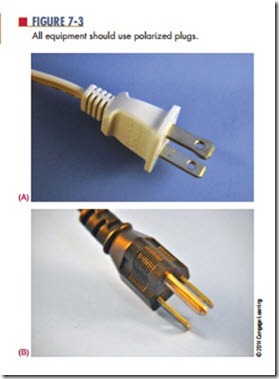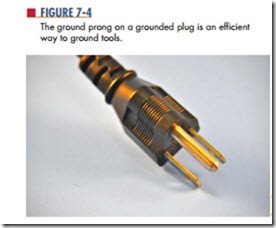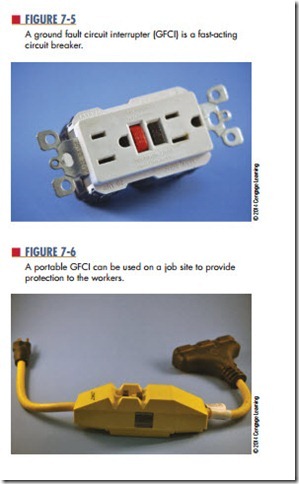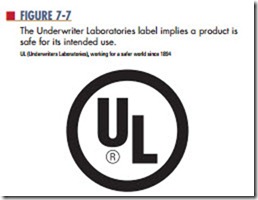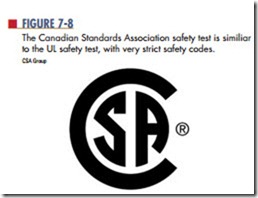Preventive Measures
Take time to be safe when working on electrical and electronic circuits. Do not work on any circuits or equipment unless the power is secured.
1. Work only in clean, dry areas. Avoid working in damp or wet locations because the resistance of the skin will be lower, increasing the chance of electrical shock.
2. Do not wear loose or flapping clothing. Not only might it get caught, but it might also serve as a path for the conduction of electricity.
3. Wear only nonconductive shoes. This reduces the chance of electrical shock.
4. Remove all rings, wristwatches, bracelets, ID chains and tags, and similar metal items. Avoid clothing that contains exposed metal zippers, but- tons, or other types of metal fasteners. The metal can act as a conductor, heat up, and cause a bad burn.
5. Do not use bare hands to remove hot parts.
6. Use a shorting stick to remove high-voltage charges on capacitors. Capacitors can hold a charge for long periods of time and are frequently overlooked.
7. Make certain that the equipment being used is properly grounded with polarized plugs. Ground all test equipment to the circuit and/or equipment under test (Figure 7-3).
8. Remove power to a circuit before connecting alligator clips. Handling uninsulated alligator clips could cause potential shock hazards.
9. When measuring voltages over 300 volts, do not hold the test prods. This eliminates the possibility of shock from leakage on the probes.
There are two techniques to prevent electrical shock when using electrical tools and equipment. They are insulating and grounding. Insulating refers to using a material that does not support current flow. Copper wire conductors are normally insulated. Hand and power tools and appliances contain layers of insulating material between the interior parts and the exte- rior housing.
grounding helps to provide a path to carry the current to ground. All appliances are grounded. Three-prong plugs are an efficient way to ground tools or appliances, as shown in Figure 7-4.
A ground fault circuit interrupter (gfci) (Figure 7-5) is a fast-acting circuit breaker that is sensitive to very low levels of current leakage to ground. GFCIs are designed to limit electrical shock to prevent serious injury. The disadvantage with GFCIs is that they operate only on line-to-ground fault currents.
Typically, these are currents leaking through insulation or current that flows during an accidental contact with a hot wire. A portable GFCI circuit is shown in Figure 7-6.
An underwriters laboratories (ul) label (Figure 7-7) on a device implies that the product bearing the label is safe for use as intended. Tests completed by Underwriters Laboratories determine whether a product meets the minimum safety standards. When purchasing a product, check to determine whether it has the UL label on it. The UL label has nothing to do with the quality of a product, only its safety.
A CSA certification mark indicates that a prod- uct has been tested and meets the requirements of
recognized standards used as a basis for certification. Only when a product has been certified to an applicable standard does it bear the appropriate CSA certification mark. Certification marks appear on a product’s packaging as well as on, or adhered to, the product it- self. For consumers, the mark provides increased assurance of safety.
A CSA Group Mark (Figure 7-8) with the indicators “C” and “US” or “NRTL/C” means that the product is certified for both the U.S. and Canadian markets, to the applicable U.S. and Canadian standards. A canadian standards association (csa) mark with the indicator “US” or “NRTL” means that the product is certified for the U.S. market only to the applicable U.S. standards.
A number of insurance companies have formed a group known as the National Fire Protection Association. Every few years, this group publishes a summary of electrical-wiring codes under the general heading
of the National Electrical Code (NEC ). The purpose of this code is to provide guidelines for safe wiring practices in residential and commercial buildings. State and local municipalities may require even more stringent codes than the NEC that must be followed. In many states, all wiring must be done or approved by a master electrician. These codes are published for both your own and your neighbor’s protection. Electrical fires can and do happen, and they can spread to adjacent homes or apartments. The rules in the NEC guidebook help to minimize electrical fires and to provide safety in electrical wiring.
Questions
1. List five ways to prevent electrical shock.
2. Who is responsible for safety in the shop?
3. What is the purpose of insulation?
4. What is meant by grounding?
5. What organization checks an appliance or power tool to ensure it is safe to operate?
